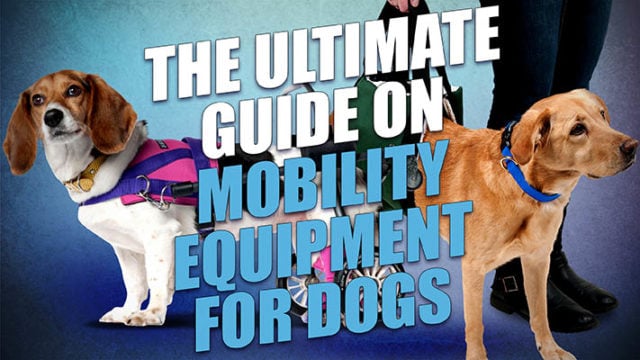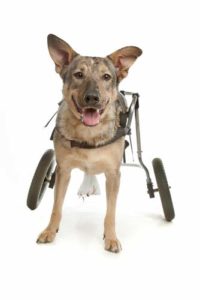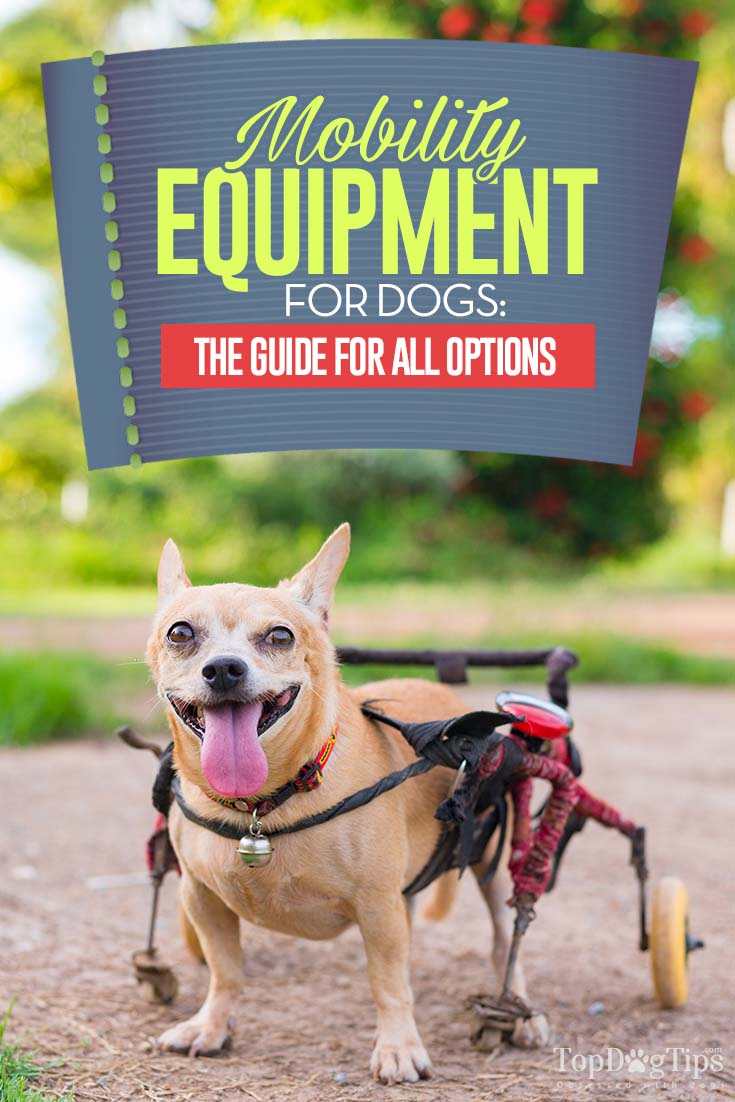
Table of Contents
Having a dog with limited mobility can be challenging. As a dog mom who parented a mobility-limited dog for fifteen years, however, I can tell you that there are many tools available that can make everyday life easier for you and your pooch. In this mobility equipment for dogs guide, I'll be sharing some of these tools and their features, some of which will hopefully give you and your Fido a comfortable and happy life together.
What is Canine Mobility Equipment?
Mobility equipment is anything designed to assist with the dog's movement when he's unable to walk and move by himself. There's a large variety of different types of mobility equipment for disabled dogs, including slings, doggy wheelchairs, mobility harnesses, prosthetics, drag bags, and everything in between. Below, I will cover every single piece of equipment, how they differ, and their pros and cons.
When Does a Dog Need Mobility Equipment?
There are many reasons that dogs may need mobility equipment:
- Dogs born with physical deformities affecting their ability to move;
- Dogs born with paralysis or nerve damage affecting their ability to move;
- Dogs born with missing limbs impairing their ability to move;
- Dogs that have been paralyzed due to accident or injury;
- Dogs with illnesses or injuries affecting their mobility;
- Dogs recovering from surgery
- Dogs recovering from injury
- Old dogs with slowed, impaired movement due to age, arthritis, or degeneration;
- Dogs with fears and phobias may lead to impaired ability to navigate stairs alone or otherwise move freely.
…and other reasons. Your choice of specific tools will depend on the exact reason why your potentially disabled dog may need mobility equipment and how and where you're going to use it. Let's start with some of the more popular, affordable options and work our way down the list.
Mobility Harnesses
The Double-Handled Dog Harness
The double-handled harness is the most versatile and supportive dog harness option. My two personal favorites of these types of mobility harnesses for dogs (and ones my family used for over a decade) are the Help ‘Em Up harness and, more recently, the EXPAWLORER harness.
These two harnesses both have a front and back portion with a topside handle over the hips as well as along the back. There are quite a few variations of this harness, but in my personal experience, the EXPAWLORER and Help ‘Em Up harnesses were the most durable and supportive, and they did not cause chafing.
This type of dog mobility harness is ideal for dogs with any type of mobility concern, but particularly those with conditions that affect weight bearing, stability, or all four limbs. I also found this type of harness to be best for senior dogs (especially larger breeds) who are unable to climb stairs or get into or out of the car.
The Single Handle Harnesses
Single-handle dog harnesses look much like walking harnesses but feature a single handle along the back. These harnesses are more ideal for hiking dogs that may need a lift once in a while or for dogs who just need a little assistance with stability. An example of this type of harness is the EzyDog Trail-Ready harness.
The single-handle harness for dogs is not stable enough to provide lift for an extended period of time because it focuses your dog’s body weight on one handle, and it causes you strain because it causes you to lift your dog like a dumbbell.
The Purse Handled Harness
This type of harness is by far my least favorite dog mobility harness. Structured as a full-body harness or a girdle-type wrap with two attachment points along the back of the harness– one at the neck area and one near the hips – this harness has a single long strap that connects to the two attachment points. I refer to these as “purse-handled harnesses” because they encourage you to assist your dog by carrying or lifting them like a handbag.
There are many reasons why this is a terrible harness structure. It puts more strain on your dog’s chest and groin area when you lift them, it creates instability as your head-heavy dog lurches forward, it provides little support with a lot of strain on the attachment points, it’s awkward to “lift,” and it puts excess strain on your back, arms, and shoulders.
Fortunately, this type of harness seems to be on the outs, but if you’d like to see an example of one of the most widely advertised purse-handled harnesses back when they were popular, look up the old version of the Solvit Carelift Lifting Aid Mobility harness.
The Single-Piece Harness
The single-piece harness is a mobility-assisting dog harness that provides a lift for the rear end only or the front end only (with a handle over the shoulders). Single-piece harnesses can be a great tool to support your dog in independent movement, but they should not be used for complete lifting as they offset your dog’s center of balance and will cause them to fall. An example of this type of harness is the Petmate Bottom’s Up harness.
This type of dog harness is most often used for dogs that have had CCL surgery and need assistance keeping weight off their repaired leg while it heals. This is generally not a harness designed for long-term use, and using it for an extended period of time can cause chafing and strain on your dog’s belly, thighs, groin, armpits, and chest.
RELATED: All Types of Dog Harnesses Compared
Mobility Slings for Dogs
Slings are another mobility aid often used for dogs recovering from surgery who need added support for a short period. The advantage of dog slings is that they are cheap, but on the other hand, there are plenty of disadvantages (more than pros, in my opinion). An example of a sling would be the Pick For Life Dog Lift Harness, which is one of the most popular options among pet owners who choose these mobility slings. You can also find the six best dog sling harnesses here for more examples of this mobility equipment type.
So, what are the disadvantages of this type of mobility dog sling? They create a lot of strain on your dog’s stomach and chest, they are inconvenient for supportive and mess-free potty time, they can impede breathing by pulling against the diaphragm, they provide no support when getting your dog into and out of the car, they are awkward for you to lift, and they cause your dog to feel unsteady and off-balance resulting in their lurching forward.
Slings are perhaps my least favorite option for mobility aids next to the purse-handled harness for dogs (covered below) because there are far too many disadvantages to them. Generally, I don't recommend them, but if there's a reason you want to choose this over any other dog mobility equipment, I recommend you discuss it with your veterinarian. For pet owners on a budget, you can make even one of your DIY mobility slings for dogs exactly the same type. Here is Samantha's guide on how to do it.
Drag Bags
If you have never met a paralyzed dog or a dog with very limited use of their back legs, then you likely aren’t familiar with drag bags. A drag bag like the Walkin' Drag Bag for paralyzed pets is a fabric bag that secures around a dog’s hind end to keep them from getting sores, cuts, abrasions, splinters and rashes as a result of dragging their rear quarters along the ground.
Drag bags are made from durable material that has some slickness to them to allow for dragging while avoiding wear and tear. A drag bag should always have proper ventilation built into it and is most helpful when lined with a waterproof material since these dogs often experience accidents due to a lack of bladder and bowel control.
Dog mobility drag bags are a necessity for paralyzed dogs for safe play and easy household movement away from their pet wheelchair. They aren’t cheap for what they seem to be, especially if you have a large dog (around $50), but it’s important to have at least two available for each dog.
Dog Wheelchairs
Wheelchairs are another necessity for paralyzed dogs to allow them time outdoors, and more companies have been developing new designs that are extremely well-balanced and allow disabled dogs to live an almost normal life. I will cover this equipment briefly below, but I recommend you read this veterinarian's guide on wheelchairs if you're considering getting one for your disabled dog. This is the second most expensive piece of mobility equipment for dogs you can purchase, and their prices vary a lot.
A pet wheelchair will protect your dog from any sharp objects on the ground that could hurt them while dragging, but it will also allow for free movement with less resistance so that your dog can enjoy time outdoors. A dog has a much easier time moving around, almost without noticing the body movement issues. One of the more popular brands of canine wheelchairs is the Walkin’ Wheels brand, which is vet-recommended. This type of store-bought wheelchair is not customized to your dog’s needs (aside from their weight), so they aren’t too expensive (around $200) when compared to customized options.
Of course, dogs that are not paralyzed can also get good use out of wheelchairs. for example, elderly dogs with mobility problems or loss of muscle mass, dogs with muscle wasting diseases, dogs with neurological disorders, and dogs with birth defects affecting the structure or function of their legs. For more options, take a look at this list of the seven best dog wheelchairs that are currently available on the market (including the pros and cons of each brand).
Most wheelchairs for dogs are designed for rear-end support; however, one company – Eddie’s Wheels – specializes in making dog wheelchairs for front or rear support and for all types of canine mobility needs. Since these types of pet wheelchairs are custom-built, they are more expensive ($400+) than the store-bought “traditional dog wheelchair,” but they provide much better support and functionality. Alternatively, if you're handy, you can make your own DIY wheelchair, which is likely to be cheaper than anything bought.
Dog Prosthetics
Prosthetics are still in their infancy as far as dogs are concerned, but over the last decade or so, great strides have been made in developing canine prosthetics that are functional and comfortable. Prosthetics are the most expensive investment you can make for your disabled dog, but they allow for a much better range of motion for mobility-impaired pets with missing appendages. For example, canine prosthetic devices from OrthoPets tend to run between $1350.00 and $1750.00 USD each. Take a look at their Instagram account (@orthopets) for more photos of what these look like.
Prosthetics for dogs cannot always be helpful depending on what special needs your pet might have. Before you decide to invest in any type of dog prosthetic and spend a ton of cash, make sure to consult a veterinary specialist (and possibly three of them) for advice and to ensure that it’s something that your dog definitely could benefit from.
Halos for Blind Dogs
The Halo is a device designed to assist blind dogs with their mobility. The blind dog Halo, like this, fits like a front dog harness and features a circular “halo” that extends around your dog’s face. The halo is used to protect the face from your dog walking into things as well as to forewarn upcoming obstacles. As the halo scrapes against a wall, your blind dog will feel and hear the Halo’s warning and know that there is something impeding their movement.
The Halo device ranges in price depending on the size of your dog but tends to run from $75 to $150. It is not a necessity for blind dogs who adjust quite well to their lack of sight, but it does allow for more freedom of movement and more independence.
Scent Dots
Scent dots are a cheaper alternative to the Halo for blind dogs. These small sticky dots carry a scent that your dog can follow like a trail of breadcrumbs. Unlike the Halo, scent dots generally only work well indoors, and they serve as a lead for your dog rather than allowing them to explore on their own.
While scent dots give your dog less freedom than the Halo, they are much more affordable. The most popular brand of scent dots is the SightScent brand, which can be purchased as adhesive dots and refill oil syringes, which are available to refresh the dots over time or to use in lieu of the dots.
One of the better uses of this type of dog mobility aid is for blind dogs in a home where the furniture has recently been rearranged or blind dogs who are entering a home for the first time. The dots will serve as a path that they can follow safely without bumping into furniture or getting themselves into trouble.
READ NEXT: Making Life Easier for A Disabled Dog
Disclosure: We may earn affiliate commissions at no cost to you from the links on this page. This did not affect our assessment of products. Read more here and find full disclosure here.






















